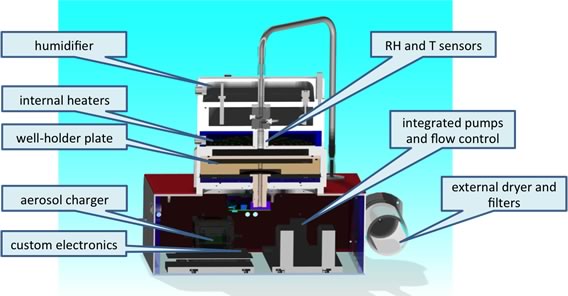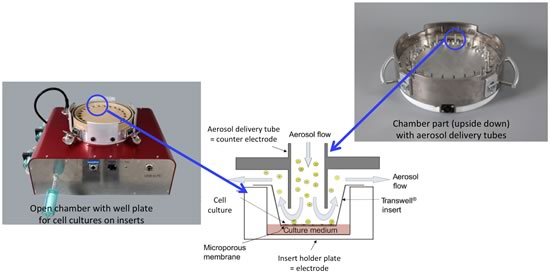 Nano Aerosol Chamber In-Vitro Toxicity
Nano Aerosol Chamber In-Vitro Toxicity
Effects of inhaled nanoparticles to normal and diseased airway epithelia by in vitro technology
Deposition Chamber
The new deposition chamber is designed to mimic particle deposition onto lung cell cultures in a realistic way, close to physiological condition.

To allow well defined deposition of particles on the cells, NACIVT contains the following features:
- Direct deposition of particles from gas flow. The particles maintain their chemical and physical properties and are not influenced by sample preparation procedures. This is critical to assess the real effects of nanoparticles on lung cells
- Efficient and even deposition of particles on the entire cell culture
- Experiments under well controlled conditions (temperature, humidity, air), mimicking particle deposition in lungs
- Quantification of deposited particles
- Exposure of 24 cell cultures in parallel allowing high throughput testing
- Stability of temperature and humidity allowing long term exposures
- Versatile and mobile system, usable directly at particle source of interest
The design of the particle deposition chamber is based on existing ones (Savi et al., Environ. Sci. Technol., 2008; Mertes et al., J. Aerosol Med. Pulm. Drug Deliv., 2013).
Prior to entering the chamber the particles are charged electrically. This can be either unipolar or bipolar.
In a conditioning chamber the particle carrying air is humidified and heated. Then the particles enter the deposition chamber, were they are precipitated by an electrical field on the cell cultures.
Electrostatic particle deposition
Animation: Electrostatic particle deposition
Advantages and Features
Nanoparticles from a large number of sources and size range can be investigated with the NACIVT system. This includes engineered nanoparticles as they are increasingly used in manufacturing processes (eg. for new materials, coatings etc.) but also nanoparticles released in consumer products such as sprays.
An alternative area of research for which the NACIVT is ideally suited are investigations on atmospheric (nano)particles from natural and man-made sources.
The NACIVT system has a compact and integrated design so that it can be transported to any particle source of interest, e.g., laboratories, manufacturing environments or atmospheric field applications.
Parallel deposition on up to 24 cell cultures allows rapid analysis, e.g., using different cell types.
Circumferential view of NACIVT.
